George R.R. Martin’s world is vast and rich, like a proper fantasy setting should be. If you can believe in the world and feel like it’s a real place, then the author has done half of the job.
From frozen wastelands to beautiful green riverlands and busy city capitals, there’s a lot of iconic sites, with plenty of elements that help to make them instantly recognizable. The Red Keep? That’s in King’s Landing! The House of Black and White? That’s in Braavos, no doubt!
The people working in HBO’s adaptation have done an amazing job in choosing the filming locations and bringing Martin’s world to life. It’s certainly no small task, but the effort has paid off. I still remember feeling amazed at the variety of places featured during the first episode of Season 1, from the moment the southern gate of Castle Black opens and we see the Wall. No teasing, no beating around the bush with that reveal -it’s a brilliant shot that gets your attention during the first few seconds of the story.
The show has come a long way, and budget constraints are mostly a thing of the past but the more modest budget of the first couple of seasons make their achievements all the more impressive.
Sacrifices had to be made for the sake of realism and practicality, however. What works on the written page may not work in a live action TV series, and many of the locales couldn’t have been portrayed the way they are described by the author.
So, for this new article I’d like to invite you for a walk in the world of Game of Thrones, and look at some of the differences (and similarities too!) that exist between the novels and the screen adaptation. Don’t worry, we’ll borrow Littlefinger’s jetpack (or one of Dany’s dragons) so the journey won’t take too long!
The Continent of ESSOS
Valyria
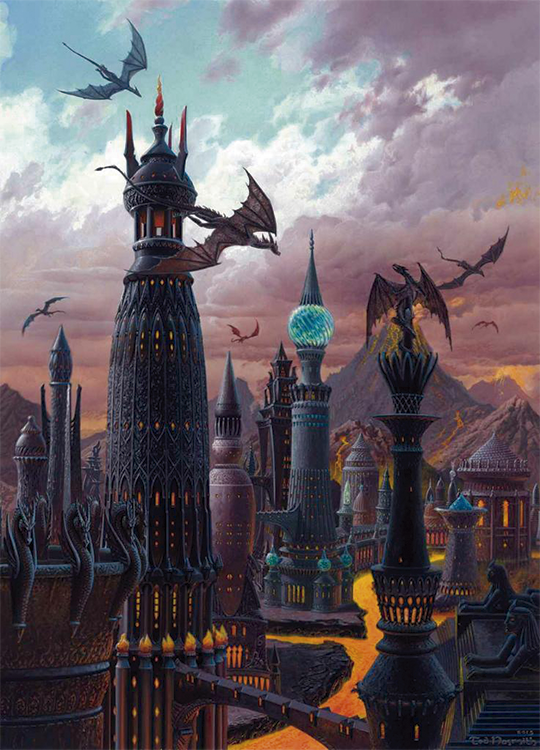
Our first stop will be the once-proud capital of the Valyrian Freehold (which was technically an empire, but there wasn’t a single ruler: all freeholders had a say).
The city was destroyed by a catastrophic event known as “The Doom”. What happened exactly remains unknown, but it was most likely the powerful eruption of a chain of volcanoes known as the Fourteen Flames, considering how it’s described as a series of explosions that filled everything with smoke and fire, along with powerful earthquakes that destroyed everything and fragmented the Valyrian peninsula. Other explanations involve magic and curses, but I think natural disaster is the most believable scenario.
In the novels, many people believe the city is cursed and full of demons, and anyone who dares to get close to the ruins would die a horrible death. It is unlikely the action in the books will take us there, but we got to see Valyria in the fifth season of the show.
The temple ruins of Angkor Wat in Cambodia served as inspiration for the show version of Valyria, appearing as charred ruins that have been largely overtaken by the jungle. Visually, it is really striking and it (possibly) confirms it’s not a haunted land crawling with horrors (though it does house the stone men, a change from the source material).
There’s precious little art for the book version of Valyria. We can see lava flowing in the streets (it was channeled in controlled flows to power up something unspecified), and also sphinxes and towers with orb-like decorations. I feel like a show version of Valyria in a live-action prequel would have a more restrained approach, without veering much into high fantasy territory.
I can only imagine some of the complications Valyrians would have to deal with in the book version of the city: unless the lava flow was constant, because of magic or any other reason, it would eventually cool off and solidify, clogging the channels. And even if the flows were controlled, to have them in the city was asking for trouble: how many distracted or drunk Valyrians had a horrible demise as a consequence?
Meereen
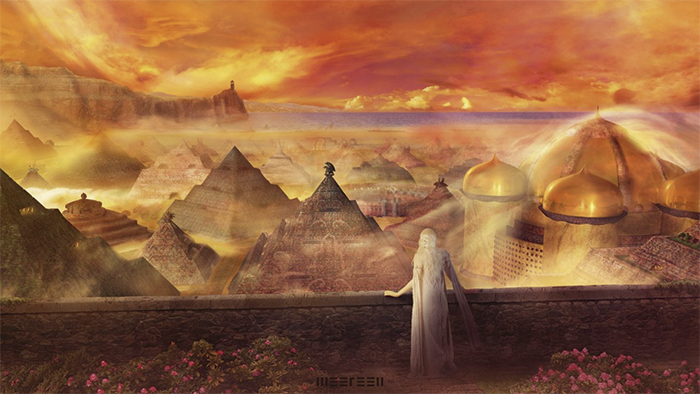
When it comes to Meereen, the crown jewel of the Bay of Dragons (formerly Slaver’s Bay), the feeling I get from both the novels and the show is of undercooked potential. For all the time we spend in there (and we spend a lot of time), we don’t get to know much about the place and its culture. We know that the Meereenese like to see the battles that take place in the fighting pits, but not much apart from that. Even during the first episode of Season Six (“The Red Woman”), when Tyrion and Varys walk through the streets, the city seems oddly empty. And there aren’t many (if any) recognizable places like in King’s Landing (such as Littlefinger’s brothel, the Sept of Baelor, Flea Bottom and streets bursting with activity).
Some little details described by Martin in the books are inevitably lost, since it’s not relevant to the plot: such as the Graces and their robes of many different colors, or the apparent love Meereenese have for eating dogs. We don’t need to see a poor pupper getting offed, but such “exotic” dishes could’ve made their way to the show.
Perhaps Meereen needed one or two more locales for the characters to interact, apart from the Great Pyramid, but with enough differences to avoid turning it into a rehash of the Westerosi capital. I get that Dany and her advisors can’t go prancing around with the Sons of the Harpy at large (and when that threat is eradicated, we leave Meereen!) but that could be solved with having an Unsullied escort following them.
That said, I think the general look of the city had a good transition from book to screen. The Great Pyramid looks amazing (and how awesome was the moment when the Unsullied bring the Harpy statue down?) and Daznak’s Pit has nothing to be jealous of, comparing to other shows and movies with Roman amphitheater-like places.
Frank Lloyd Wright’s Mayan Revival architecture was a main inspiration behind the Great Pyramid, Hollyhock House and the Ennis House in particular.
The FREE CITIES of ESSOS
Braavos
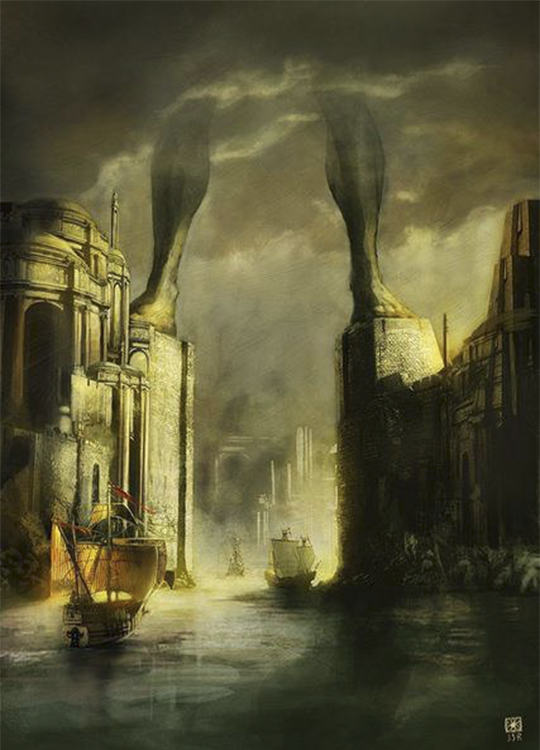
Braavos is a sprawling group of islands connected with stone bridges. Not many trees or any kind of vegetation to be seen, but there are many different canals and also ports scattered all around the city, for ships and boats to arrive.
There are many different temples (all gods are worshipped in Braavos, and none is above any other), brothels and inns. You could say it’s possible to find anything you want, with the exception of slaves, however, that sort of commerce is forbidden.
Apart from the House of Black and White, the guild of the Faceless Men, Braavos is also home of the Iron Bank, the richest bank in the known world and financial backer of the Iron Throne since the time of Robert Baratheon. And like any bank worth its salt, they merciless and if you owe them, they’ll find a way to make you pay.
The real-life inspiration for the towering Titan of Braavos surely is the Colossus of Rhodes, a 108-feet tall statue of Helios that once stood in the greek city of Rhodes. The Colossus’ stay was short lived, since an earthquake reduced it to rubble.
The show’s version of Braavos looks like it jumped straight out from the page. I’m still amazed at how perfectly they nailed the look and feel of the city, with its busy and noisy streets, and even showing the need of having to use a boat to go to certain parts, in Arya’s case, to the House of Black and White. The building itself isn’t quite how I imagined it when reading, since I was expecting something more temple-like. Not too flashy (these are assassins we’re talking about), but perhaps more aesthetically pleasing than a rocky block. Its size and lack of windows make it rather intimidating, however. Production designer Deborah Riley looked at Varanasi on the bank of the Ganges and the way the buildings rise out of the water as inspiration for the House of Black and White.
On the other hand, the interior of the House of Black and White is downright amazing, the Hall of Faces in particular. I had in mind something like Marc Simonetti’s illustration for the 2013 ASOIAF calendar, but the show made it bigger and more impressive. The candle lighting and Ramin Djawadi’s score give it an ominous feeling unlike any other place in Westeros. The Ellora Caves in Western India and the Temple of 1000 Buddhas in Hong Kong were the real-life inspiration behind it, and as Riley herself says: you lay the two of them atop each other, and you get the Hall of Faces.
The Continent of WESTEROS
Highgarden
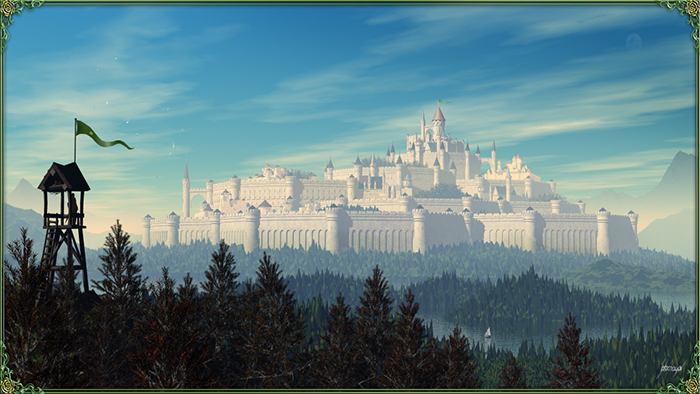
One of the things I love about Highgarden is that it’s a like a castle out of a fairy tale, with its white stone walls and a hedge maze that is designed to entertain and to slow enemies down in case of invasion. (Alas, a hedge maze certainly won’t stop them, but it takes time to either cut or burn a way through it!) All structures are covered in a variety of vegetation, such as ivy and climbing roses. These people take their gardening/flowers motif seriously!
There are groves, fountains, flowers and statues within the wall, as well as all kind of musicians: singers, fiddlers and pipers. There are even pleasure boats to sail along the Mander (the largest river in the Reach).
All the grandiosity showcases House Tyrell’s wealth and power (whether or not they’ll prove to be easily defeatable “golden roses” remains to be seen in the books), and their love of comfort and a relaxed and peaceful lifestyle are apparent, a contrast with many other noble houses with a preference for warfare. I certainly can’t see either Roose Bolton or Randyll Tarly listening to music or sailing in a pleasure boat!
The show offered a small glimpse from afar during the third episode of Season 7, “The Queen’s Justice”, when the Lannister forces take Highgarden. The Castillo de Almodóvar del Río in the Andalusian province of Córdoba, and the Trujillo Castle in the province of Cáceres were used to portray the Tyrell castle on-screen. It is not white, and doesn’t seem as big as its book counterpart, but the showrunners kept some bits: the vines in the walls, lush vegetation around it, and a fountain in the courtyard.
The show’s version of Highgarden is more or less how I imagined it, with the exception of the color: it was indeed completely white in my imagination. Nevertheless, it was satisfying to be able to finally see it, if only for a few seconds, after reading and hearing so much about it.
Casterly Rock
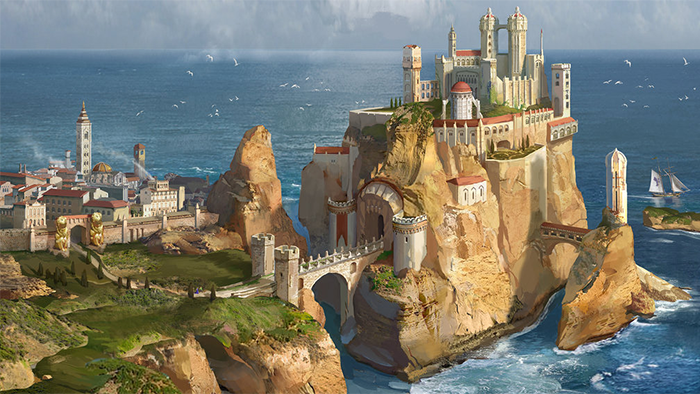
As it was the case with Highgarden, Season 7 offered us a glimpse of the Lannister stronghold during the third episode.
It sits atop a rocky hill beside the Sunset Hill. But here’s the thing: said rocky hill is said to be three times the size of The Wall. It is truly immense, and the live-action version is not as imposing in comparison. This was most likely a matter of keeping it realistic and practical: it would’ve been way harder to stage the attack of Dany’s forces otherwise, though I can picture the Unsullied climbing the hill in a similar way the wildlings and Jon did at the Wall. The brevity and flow of the scene required something less complicated, not to mention it would’ve required extra stunt work and digital effects.
No real-life castle was used as a location: all of Casterly Rock consists of sets and VFX work, and we really didn’t get much of a close look. I must say that at first I was a bit surprised at how plain-looking it is in a way: No statues or any kind of ornamentation, just white walls and halls. And while Tywin wasn’t a pompous man, the way the Lannisters have adorned the Red Keep and personalized their weapons, armor and jewelry, among other things, mainly with a lion motif, the contrast was noticeable. You’d think there would be a Tywin statue somewhere, not for vanity (as it was Joffrey’s case), but as a constant reminder of who is in charge. There’s in fact a bit in A Feast for Crows in which a stone statue of Tywin is commissioned in honor of the recently deceased Lannister patriarch.
The Game of Thrones version of this castle didn’t live up to my expectations. But I wouldn’t say it wasn’t well-made: it did the job and there was excitement in how Tyrion’s plan was foiled by his siblings. For that alone, it was worth it.
Dragonstone
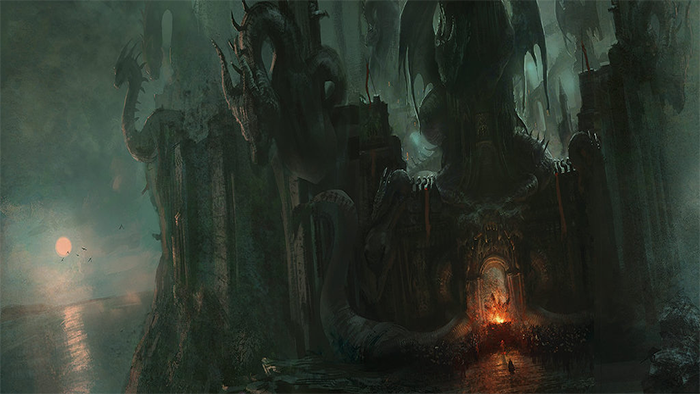
Stannis famously disliked Dragonstone, because it was a cold, damp place on an island where nothing grows. But for Daenerys, it was like coming home, at long last. She was born on Dragonstone, after all.
The ancestral Targaryen castle is a fascinating place in the novels, built with stone and shaped like many dragons of different sizes. There are dragon statues all over the place, as well as dragon-related ornaments (in the shape of dragon wings, dragon tails and so on). Gargoyles and many other fantastic creatures in the battlements. Clearly, the Targaryens pulled out all the stops when building this castle. But while do I like to imagine descriptions such as the Great Hall of Dragonstone shaped like a dragon lying on its belly (and I mean, that Marc Simonetti art of the castle is quite badass), there can be too much of a good thing, and I think that a faithful portrayal in the screen adaptation would’ve been overkill at best or cheesy at worst. Not even Count Dracula had bat-shaped everything at his castle, and you can’t say he lacks style. Now, Batman, on the other hand…
But I digress. Point is, the show version of Dragonstone is more restrained and I think it’s better for it. The dragon ornamentation is limited to a couple of big dragon heads flanking both sides of the iron gate entrance (the heads are clearly inspired by the feathered serpent heads on the Quetzalcoatl temple, located in Teotihuacan, Mexico).
An element from the novels that was kept is the Painted Table. Originally commissioned by Aegon the Conqueror, it was later used by Stannis Baratheon and is currently owned by Aegon’s descendant, Daenerys. It’s a very cool prop that matches its book description, looking both useful and cumbersome. Can’t really carry it with you, which tells me the Conqueror should’ve asked for a detachable table that could’ve been disassembled and then put together again.
Winterfell
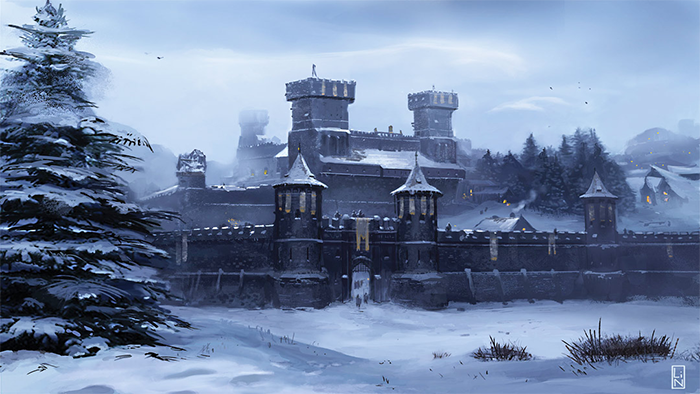
Grab your furs and a cup of hot cocoa, because we’re going to a very cold place.
Winterfell is the ancestral home of House Stark, located in the North. It was built atop natural hot springs that keep the castle warm and its occupants comfortable.
Inside its big, thick walls there’s a godswood, a courtyard and several towers, one of which is broken and the other abandoned.
The show version of Winterfell is large, and yet it’s somewhat smaller than its book counterpart, which is a massive castle and couldn’t have possibly been portrayed that way during the smaller-scale first season of the TV series. It doesn’t need to be enormous, in any case, as it seems there’s more than enough space for the Stark family and even several guests (as seen when King Robert Baratheon visited).
The library tower was omitted from the show, whereas in the novels Tyrion spends time reading in there, and later someone (most likely the catspaw assassin) starts a fire in the tower. Can’t say I missed these moments much, since later we learn that Tyrion likes to read anyway (when talking to Jon) and the assassination attempt on Bran worked just the same.
I like Winterfell as a whole, in both books and show, but if I had to pick a favorite part of it, I’d go with the godswood. It was perfectly realized in live action, and offered one of the few moments between Ned and Catelyn. How I miss both of them! There are difficult times ahead for the remaining Starks, but if they (and Winterfell) managed to survive the Greyjoys and the Boltons, surely some undead won’t be the ones who buck the trend.
Water Gardens
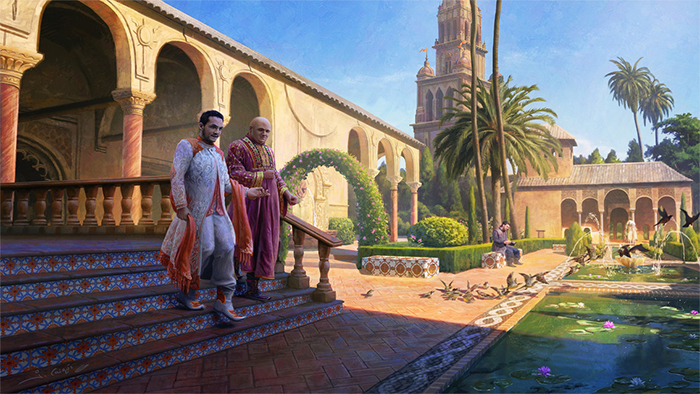
When it was announced that the Alcázar of Seville would be used as the location for the Water Gardens, I was very excited. I had the fortune of visiting the Alcázar a few years ago, and words don’t do it justice. It was an inspired choice for the Dornish palace, just perfect. Even if the Alcázar wasn’t what Martin had in mind when writing the novels, it fits the description really well, with the pools, the fountains and all the greenery, like an oasis in the desert-like environment of Dorne.
The Dorne storyline in Season 5 was objectively lackluster, though, and its poor reception with critics and fans alike resulted in the elimination of all things related to it: We never got to see Sunspear, for example, and the arcs of characters like Doran were cut short. It’s a real shame, because I keep picturing other magnificent places that could’ve been other parts of Dorne, like the Alhambra, with its own “water gardens” in the Generalife, intricate carvings, marble floors and stained glass, or the Mezquita in Córdoba with its red and white arches and marble pillars.
I don’t think Dorne will receive a second chance any time soon, in either the coming spin-off or other GoT-related media (with the exception of the forthcoming novels, of course), but at least we got to be in the Water Gardens for a bit of time.
Harrenhal
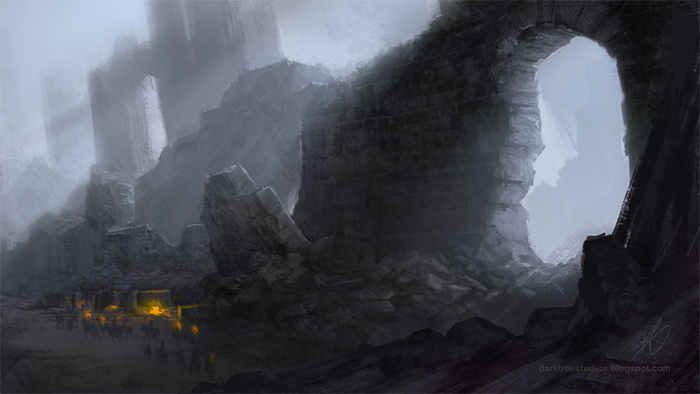
This castle isn’t just big, it’s the largest in the whole continent. But size alone couldn’t spare this building and its original occupants from getting burned to a crisp by Balerion the Black Dread. The dragon fire left Harrenhal a melted and charred ruin that has since fallen into disrepair, rotting away with time.
Not only is the castle too big, it’s expensive to repair and maintain. Just like Jaime said to Bronn, “Think of the upkeep!”
Ever since the death of its founder, King Harren Hoare, the castle has changed hands many times, and it has always meant bad luck for its new tenants, since all of them have met a horrific death. (Curiously enough, both Tywin Lannister and Roose Bolton held Harrenhal and were later killed by their own sons.) This has led people to believe the castle is cursed.
Though in the show we mostly see the castle interiors and not much from the outside, the sets are very well made and the camera angles help to make it look like a real place.
If I miss something from the novels, it’s Arya being the “Ghost of Harrenhal”, exploring the castle while doing her chores, and sleeping beneath the Wailing Tower at night. I wanted to see the ruined sections of the castle and the bat-infested ceilings, but I understand that budget and time limitations didn’t make it possible.
Men fear the Wailing Tower and the stories of the ghosts that inhabit it, but Arya knows better – ghosts can’t do harm, but living men can.
Riverrun
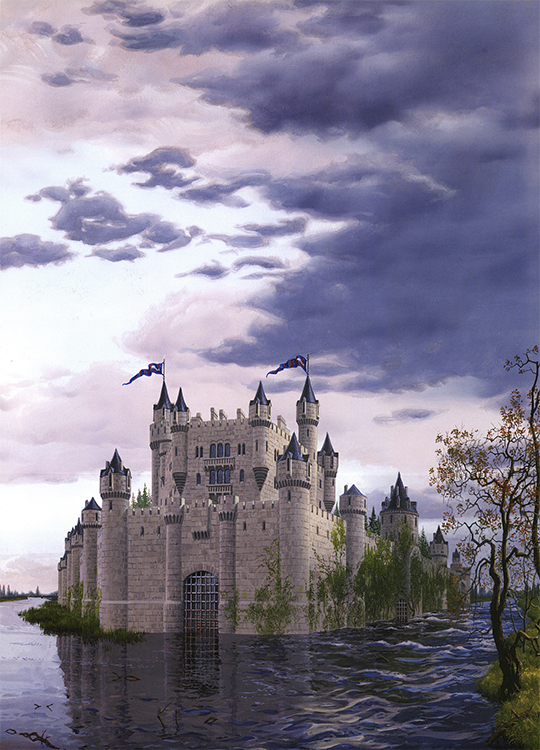
There, between rivers and surrounded by green, rich lands, stands Riverrun, the former seat of House Tully- currently with an unknown status. It was in the hands of the treacherous House Frey, but considering Arya Stark killed Walder Frey and all his male heirs, the castle seems to be up for grabs.
Riverrun may not be the biggest castle in Westeros, but it has one of the best defense systems: in case of siege or invasion, the sluice gates can be opened to turn it into an island fortress, rendering it almost impossible to assail. Sure, it can still be attacked with catapults, but any invading soldier would have to swim to reach it, a difficult proposition when one is wearing chainmail and armor.
The show version of Riverrun is quite similar to its book analogue, particularly to the interpretation of the artist Ted Nasmith. The glimpses we get from the outside are few and brief, mostly from a distance, but we get to spend more time inside, in the main hall and the garden.
Though many important moments from the novels are kept (like Hoster Tully’s funeral, Cat talking to the Blackfish and Jaime seeking to parley), some elements from the castle were lost, such as the Wheel Tower and its waterwheel. And just like in Winterfell, there’s a heart tree inside. No serious omissions to be honest, but they could’ve been nice touches.
Though the front gate of the castle was built on Game of Thrones, the rest of the structure was digitally made. As is the case with many other locations, the digital parts blend so well with the practical ones and its surroundings, it’s hard to notice Riverrun is not a real place!
The Eyrie
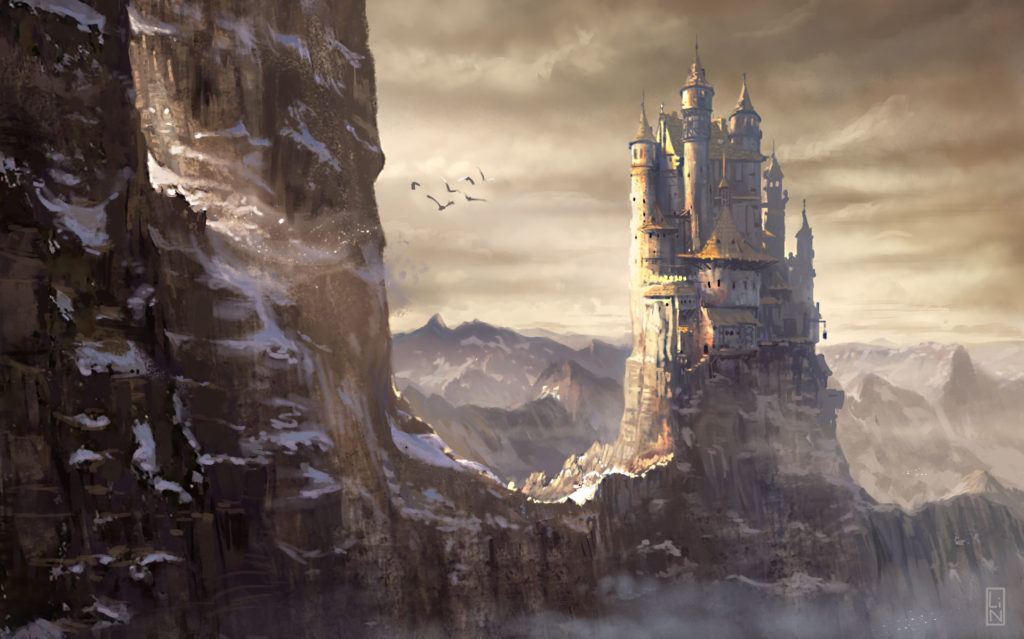
This is one of the instances in which I feel the show limitations in regards to budget actually helped to improve on what was on the written page. The castle itself is tinier and the climb to reach it less troublesome- in the books it can take half a day, at best. Just imagine being the lord or the lady of the Eyrie, finally reaching the Gates of the Moon located at the bottom of the mountain, and then remembering you forgot something at the castle! It’s not very practical at all, but the need to go smaller pays off in spades when it comes to the Moon Door.
In the novels, the Moon Door is an actual door made out of weirwood, and it stands vertically, not on the floor. Its purpose is the same, opening to a precipice in order to make “people fly”. But I’d say the show version, the hatch that opens to a very long fall, effectively adds to the feeling of vertigo and turns the Moon Door into an unique kind of death trap, since going with a vertical door would be, in a way, a repeat of the Sky Cells.
Because of its isolated location in the mountains it’s likely we’ve already seen all the action that could’ve taken place in The Eyrie during Season 1 and the A Game of Thrones book, but at the same time its status as a castle that has never been taken by an invading army makes me wonder if it’ll play a part in Season 8, when the army of the dead march into Westeros (not that it would help much against an undead dragon, truth be told).
One small detail worth adding: the show version of The Eyrie was actually retconned during Season 4. It’s but a small glimpse and the changes are subtle and therefore easy to miss, but instead of a single rocky top, the castle now perches on two of them (the empty space in between makes better sense for the Moon Door). It also seems to have sprouted additional towers and gotten shorter, but still very cool to look at!
Oldtown
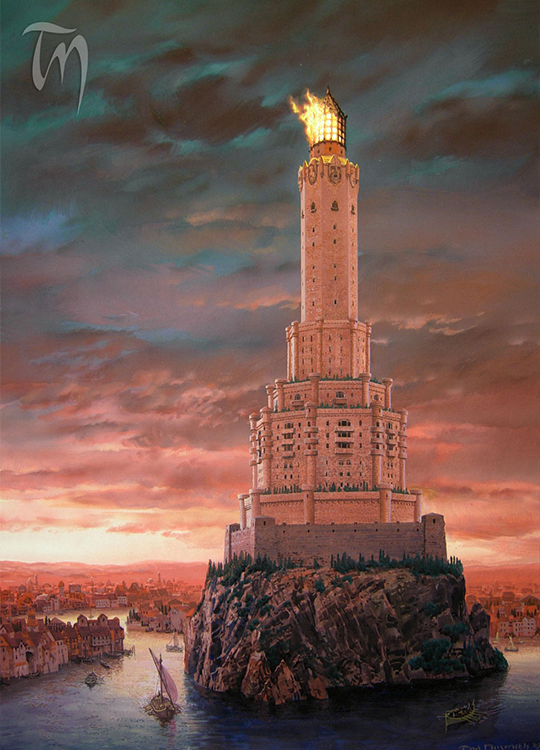
When we reach Oldtown during the Season 6 finale (“The Winds of Winter”), the awe Sam and Gilly feel is palpable. It’s the antithesis of King’s Landing- a big city but beautiful-looking with a pleasant smell, and well-organized streets that serve as evidence a lot of thought and planning went into the construction of Oldtown. No shantytowns or Flea Bottom-like nasty slums!
It’s a shame we couldn’t see much of the city itself, since a handful of moments from the books that take place in Oldtown were discarded and Sam’s own arc was cut short and changed quite a lot. It’s understandable, both in terms of budget and storytelling, but I definitely missed the Quill and Tankard Inn and the cobbled, clean streets (quite a contrast from the image we have of big medieval cities).
The Hightower did appear in the show, and is spectacular-looking, with its great beacon on top. It was also fitting that it’s one of the first things Sam and Gilly see when arriving (I mean, it’s hard to miss) under a clear day and a radiant sun, and the last, before they leave under the cover of night in a rather bittersweet moment.
The Citadel was kept as well, since it’s integral to the plot. We don’t see it from the outside, but we got to visit its immense library, the largest in the known world. Those of us who love books would certainly love to visit! The rest of it is plain-looking, but that is to be expected from a place full of scholars. Most people are there to study, after all. There’s no need for embellishments or unnecessary distractions.
We are left to wonder if the showrunners would’ve kept the couple of green sphinxes flanking the gates of the Citadel. They do make a partial appearance in the “Complete Guide to Westeros” extra from the Season 1 Blu-ray set. I imagine that if they had been able to make the jump to live-action, the designers would’ve tried to make them look unique to the world and not Egyptian-style since that could’ve felt out of place.
Pyke
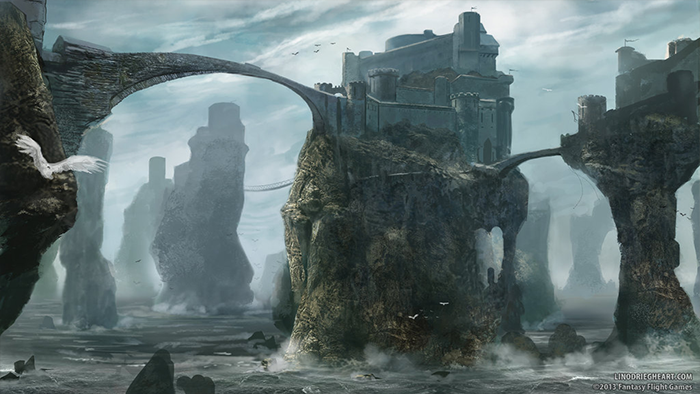
I don’t know what it is with the people of Westeros and their predilection for impractical and sometimes mortally dangerous households, but here we have yet another example of that: Pyke is a castle located on an island of the same name, sitting rather precariously on rocky towers, with its parts connected by swaying rope bridges. To be fair it was formerly a cliff that has been eroded by the sea, but if that’s not a sign that it’s probably a good idea to move, I don’t know what is.
The idea is neat, however, and I have to give Martin mad props for coming up with these crazy buildings. The show keeps some of the important parts: the look from outside, the rope bridges and Lord Balon’s solar, but leaves out the kitchen, the Bloody Keep and the Great Keep (where the Seastone Chair/Salt Throne is located).
Should the Greyjoy siblings make it to the end of the show (or Yara at least), I wonder if we’ll get to see the famed throne of the Iron Islands. I have a feeling that we won’t, and a coronation similar to Euron’s will be the end of it. It probably isn’t worth it to build a new prop that would only get a few seconds of screen time, if that.
When the Kingsmoot took place in Season 6 (Episode 5: “The Door”), it happened on Pyke and not in Old Wyk like in the novels, most likely to avoid the trouble of introducing a new place (even if technically part of the Iron Islands) when the audience is already familiar with the home of House Greyjoy. I was left wanting to see Nagga’s Hill (the story of Nagga and the Grey King already introduced in the “Histories & Lore” bonuses from the Blu-rays), but alas, it was not to be.
King’s Landing
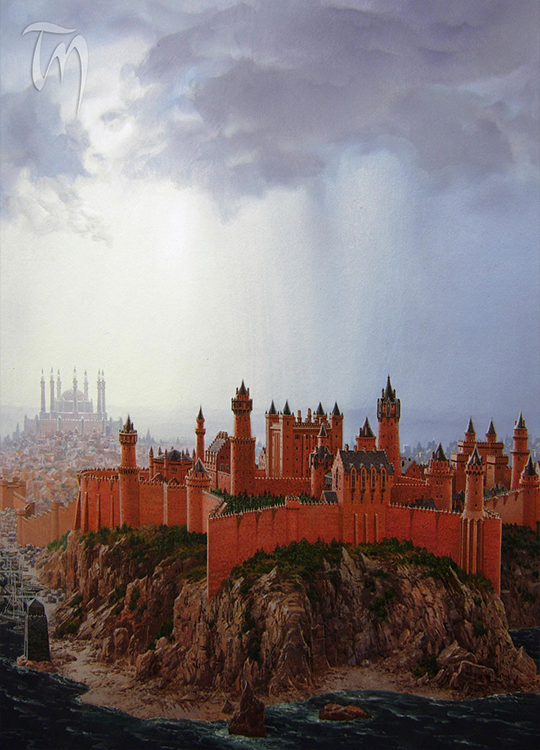
The capital city of Westeros was founded by Aegon I Targaryen, and the name comes from the fact it is situated on the spot where Aegon’s ships first landed from Dragonstone to begin the conquest of the continent.
Despite being home of the Red Keep and the Iron Throne, many characters feel nothing but derision for King’s Landing. Crime is rampant, it’s unsightly, smelly and overcrowded. Lady Olenna in fact confirmed “you can smell the shit from five miles away”.
And yet, it’s hard not to feel great esteem for the capital, as readers and watchers. After five books and seven seasons, we have grown familiar with it and its many iconic landmarks: the sketchy alleyways of Flea Bottom, the beautifully built and decorated Great Sept of Baelor and the grand Red Keep.
Quite a significant change from the books is how King’s Landing is presented as a warm, kinda tropical place; Malta and Croatia have been used as filming locations for the exterior shots of the city. George R.R. Martin said he had in mind something more akin to medieval Paris or London.
The Red Keep itself doesn’t exist in real life, its interiors are sets and digital effects help with shots from outside. Its looks more or less match the many interpretations from different artists, and the book descriptions to a degree, with the notable exception of the color: it’s named Red Keep but it doesn’t look so red. It’s sort of a very pale red. This one change puzzles me somewhat, it doesn’t “ruin” it by any means, but it sort of takes a bit of its impact away, particularly when you have stories such as the color coming from the spilled blood of Aegon’s enemies (which of course isn’t true, but I would’ve loved a brighter red. It comes down to personal preference in the end).
The interiors of the Red Keep are breathtaking. One look at the Great Hall with the Iron Throne is all it takes to be mesmerized by all the artistry and work that went into it, with the large columns, decorated marble floor and a stained-glass window behind the Throne.
The Throne itself is now a pop culture icon: even people who haven’t read the books or watched the show know what it is when they see it. This is not a knock on the novels, but the show version of the Throne is yet another example of how simpler, smaller designs can be more effective than big, over-elaborate ones. I cannot see the enormous, asymmetric pile of swords from the books that require many steps for the king to reach the top and sit on it becoming this famous, let alone working well in a filming set.
King’s Landing has appeared in all novels, and in most episodes of all seven seasons. We can only wonder what’s in store for the final season, but a battle is to be expected, either between the living and the Night King and his army of undead, or between Cersei and Daenerys.
The Wall

Well, we have reached our final destination: the Wall. Like the Iron Throne, it’s one of the elements from the world of ASOIAF/GOT that most people can identify in an instant. Big wall of ice? There’s only one book/TV series where you can see it!
You’d think there’s not much that can be said about it, and you’d be right, but there’s a small difference: the show version has a “scythe”, a giant pendulum-like bladed weapon attached by a large chain that when is dropped obliterates everything on its path. The only time we have seen in action was during the ninth episode of Season 4 (“The Watchers on the Wall”) when Dolorous Edd orders it to be unleashed on wildlings climbing the Wall. Suffice to say, nothing remained of them.
For a long time the Wall served as a large-scale Chekhov’s gun that was introduced from the beginning of the story and finally crumbled down in the Season 7 finale (“The Dragon and the Wolf”) in a way that I frankly didn’t see coming. (Well, I did see it coming after Viserion was turned, but for a long time “undead dragon” was not among my theories).
The entirety of the Wall didn’t come down, however- only the Eastwatch portion. Castle Black still stands, and the brothers of the Watch will no doubt play a part in the upcoming final season of the show.
And so, our little journey through the world of Game of Thrones concludes. Some places were left out, since there was not much material to work with (such as the Dreadfort), but I hope you had as much fun reading as I had writing and remembering my own trip through the novels and the TV show, from the very beginning.
It’s been amazing to watch the world of Westeros grow, both in number of locations and different cultures, and to see many of our beloved characters visiting new places far from their homes and everything they know. And though it is likely we won’t see many new places in the eighth and final season, we’ll certainly see them under a different lens. King’s Landing is going to look very different now that winter has come, and the major battles ahead will change the face of Westeros in one way or another, regardless of who comes out on top.
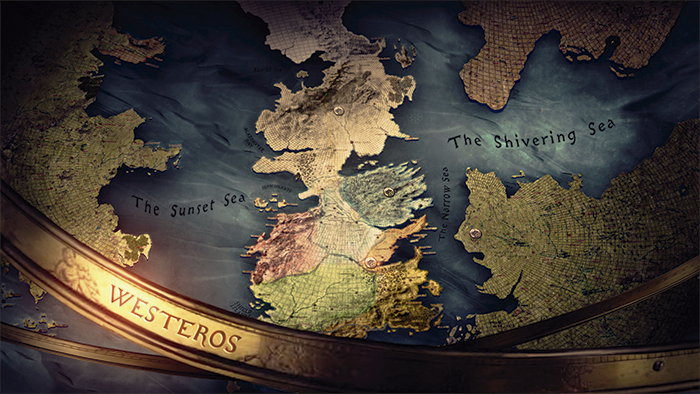
Please dear God replace objectively with subjectively when referring to the Dorne storyline. Yeah, most book people didn’t like it because it was unrecognizable from the books, but I enjoyed most of it tbh and I know a lot of other non book people did. Opinions on art are never objective! Otherwise great article on the locations.
LatrineDiggerBrian,
Book people didn’t like Dorne in the show because Dorne in the show was horrible writing. It started terrible at the beginning of season 5 and got worse from there. And a big reason everyone hated Dorne so much was because Pedro Pascal was so fantastic in season 4.
I hated Dorne in the books too. I’m very glad the show didn’t include all the book stuff.
I loved Oberyn in the show, but I didn’t like the Sandsnakes. Luckily they didn’t have much screentime.
Joey,
I think it’s very hard to reconcile when you like a storyline in the books, and then the characters are changed so much they’re unrecognizable. So of course they’re going to think it’s bad writing. Myself, I enjoyed most of it. Had a little bit of an anti-climactic ending, but I actually would’ve liked to see more from those characters, particularly Doran and Areo Hotah and the maester and even the sand snakes. I liked the interplay between Jaime and Bronn, like the scene in the jail with Bronn and the Sand Snakes, didn’t mind the fight (it’s not the catastrophe people make it out to be ) and actually was pretty cool with the whip cracking and Ramin’s awesome musical score. All the locations and costumes were awesome.
One thing I often find myself saying while watching GOT is: I can’t believe this is a TV show! Settings are certainly a tremendous reason for that. It’s quite remarkable, really.
If there’s one place I’d like to see that has not made an appearance would be “The Neck.” I would love to see Meera’s world. I won’t hold my breath for that, however.
Wonderful article, Morgoth!
Btw, indeed I did set fire to Winterfell’s library tower, but I swear I was just trying to get warm. It’s colder than Maggy the Frog’s teet up in the North!
TV highgarden was nothing like the book description. Had none of the grandeur expected from the second wealthiest house. Horn Hill is far larger in comparison. Totally robbed.
Likewise tv Casterly Rock was a massive disappointment.
About Harrenhal:
”This castle isn’t just big, it’s the largest in the whole continent. But size alone couldn’t spare this building and its original occupants from getting burned to a crisp by Balerion the Black Dread. The dragon fire left Harrenhal a melted and charred ruin that has since fallen into disrepair, rotting away with time.”
———————-
I thought it wasn’t just Balerion; it was Meraxes and Vhagar too.
Arya & Tywin (2×07)
Tywin: “Harrenhal was built to withstand an attack from the land. A million men could have marched on these walls and a million men would have been repelled. But an attack from the air with dragon fire … . Harren and all his sons roasted alive within these walls. Aegon Targaryen changed the rules. That’s why every child alive still knows his name 300 years after his death.”
Arya: “Aegon…AND his sisters…It wasn’t just Aegon riding his dragon. It was Rhaenys and Visenya, too. “
Tywin: “Correct. A student of history, are you?”
Arya: “Rhaenys rode Meraxes. Visenya rode Vhagar.”
Tywin: “I’m sure I knew that when I was a boy.”
Arya: “Visenya Targaryen was a great warrior. She had a Valyrian steel sword she called Dark Sister.”
LatrineDiggerBrian,
I liked Dorne..until they pulled the plug and ended it prematurely. And I liked Tyene & Bronn together. I was sorry to see Alexander Siddig’s tenure abbreviated, and contrary to popular opinion, I was not thrilled with Ellaria’s character or her narrow-minded “plan.”
I have to say: the settings were phenomenal. The Water Gardens were beautiful.
Dornishman,
Agreed. I was terribly disappointed by TV Highgarden; I thought it would have been fitting for viewers to have finally seen the loveliness of Highgarden right before Olenna’s death, and then felt the emotional impact of its fabled beauty facing an uncertain future.
Thank you for the article, Morgoth! One wee correction, though: When you write, “The dragon ornamentation is limited to a couple of big dragon heads flanking both sides of the iron gate entrance (the heads are clearly inspired by the feathered serpent heads on the Quetzalcoatl temple, located in Teotihuacan, Mexico),” you forget the dragon ornamentation in one of my own favorite rooms in the GoT world… the map room!
To Erica’s comment I will add that two of the places I would love, love, love to see (but don’t expect to) are Greywater Watch and the Merman’s Court. But given Howland Reed’s importance to Ned Stark and the fact that the SexBoat is on its way to White Harbor, I’m still holding out hope for at least one of them. 😜
LatrineDiggerBrian,
Thank you!
Honestly, I’m among the fans who liked the show version of Dorne, and I was sad we didn’t get to see Sunspear and more of Doran, Hotah et al. But I think we can agree that while the intentions were good, the execution was flawed and it led to the dornish getting nuked from the series.
But alas, something was better than nothing. 🙂
Morgoth wrote:
Ignoring for a moment costs and the other vagaries of TV production, this lack of detail might have another explanation. In the final chapter of Democracy in America (1835), Alexis de Tocqueville opines that an area fully dependent on slavery has a different ‘look’ due to the unique mix of social and economic forces at work, there.
He suggests that a slaveholding town appears less active. For one thing, itinerant workers and vendors would likely stay away — in the absence of free & open market conditions, they can’t compete. Likewise, manufacturing and even some trades are suppressed. Why go to town if you can afford to lard your plantation with every imported luxury?
We can debate his conclusions, but the overall accuracy of his notes seems to be above reproach; other diarists/historians of this period (north and south) recorded similar observations. Here’s an excerpt. Tocqueville is comparing & contrasting two areas on opposite sides of the Ohio River; ‘left bank’ = slaveholding Kentucky and ‘right bank’ = Ohio.
What a wonderful article.
mrf,
Thank you so much for sharing this! I’ve read it several times before, but had not thought to connect it to the different ways King’s Landing and Meereen are portrayed.
(And this is one of the reasons I love this site so much–the brilliance and insight of so many contributors and commenters.)
Very interesting article! It reminded me how much I loved the book description of places, and how well the show kept what they could of the magnificance while paring it down. Would have liked to have looked at House of Undead, The Great Sept and other similar places.
I don’t think King’s Landing is really shown as tropical in the show, both Malta and Croatia are Mediterranean in climate and the vegetation is fairly hardy, typical of sub tropical zones. So more like LA or the eastern Cape of South Africa really.
If KL was shown to be more obviously temperate like Paris or London then falling or lying snow wouldn’t look out of place and it would take away all the impact of the characters seeing falling snow in KL against the more lush backgound when we see it (since quaternal or other seasons in Planetos don’t work the same way as our world – and it’s easier with narrative to convey that than visually).
Great article!
As for how various castles’ show versions compare to the books, well, Martin famously loves larger-than-life aesthetics, not only in architecture. The book characters wear breathtaking jewel-adorned armors in vibrant colors, cloaks made of feathers, helms with huge horns or dragon heads or what have you. The book world is unmistakably fantastical from the first moment, while the show aesthetics are much more grounded and realistic, for better or worse.
I do think they could have been a little bolder in how they depicted certain legendary castles. I understand why Winterfell is much less grand in its severe and harsh beauty – Season 1 had a limited budget which probably made it prohibitively expensive to run wild with Winterfell design. I must confess I was a bit let down by the new castles in Season 7. Both Highgarden and Casterly Rock are legendary seats of great and insanely rich noble houses. The Rock was at least perched upon a high bluff next to the Sunset Sea, though it was of a rather plain design. Highgarden, on the other hand, was a real missed opportunity: there was none of its mythical grandeur and fabled beauty. When you see that there are certain real castles that look as if they have come from a fairytale, I can’t help but be disappointed with TV Highgarden’s unremarkable depiction.
Re: the Eyrie. The show also did a great job with the Sky Cells. You could really feel the terror and coldness of the place. The scenes with Tyrion nearly rolling out and being menaced by the guard were beautifully done.
Thanks for providing this reminder! Indeed, under slavery, fewer people would be on the streets and there would be police-type figures everywhere looking out for escaped slaves, checking travel passes, and generally harrassing anyone who look as if they might be property. There would be coffles of enslaved people being shuffled down the streets, to work locations or for sale. Of course, we’re pretty much spared all of that, because the first thing Daenerys does is liberate all enslaved people. But the habits of few independent merchants and vendors would most likely remain.
Nice article and Merry Christmas, Morgoth. Got you a Dos a Cero t-shirt but I don’t know where to send it.
Ten Bears,
Really wonder what D & D had in store for Dorne. It was so clear from the beginning of S6, with the bizarre Sand Snakes in King’s Landing hunting down Trystane that they made an awkward change to the scripts late in the game. Sigh, if I have another criticism of D & D, is they give into criticism way way way to easily. They’re very soft and don’t stand their ground. The criticism from S5 really affected them, sadly. Wouldn’t surprise me if they read a lot of the message boards. They should’ve stuck to their guns.
Morgoth,
Meh I dunno if it was that flawed. When I think of the S5 Dorne arc, there are really only two scenes I didn’t like. The one was the odd one with Ellaria and Jaime, and the other was the last scene which was so obvious. Other than that was fine.
Morgoth,
Morgoth:
Just wanted to chime in and thank you for that great article.
I especially liked the concept art for each location.
From my perspective as a “pre-books” (show-only) fan, I really can’t compare how the locations are described in detail by GRRM and how they’re portrayed on the show. I will say this:
• Despite the relatively short duration of the scene, e.g., Tywin looking out the window while talking with “cupbearer” Arya, I was really impressed by the “blasted ruin” of Harrenhal.
• Though I understand some CGI enhancements were used, Riverrun was gorgeous, e.g., when Brienne and Poderick with his “keen military mind” approached it from a distance.
• I guess Highgarden looked kind of…sterile? Margaery had made it out to be this lush paradise. I think. Or maybe it’s because I’d buy anything Natalie Dormer is selling.
• I did like the split-second shot of the waterfall on Bear Island right before the introdction to Lyanna Mormont.
• Braavos was spectacular: That Titan statue looked so real; the photography of the street vendors, canals, and throngs of people going about their everyday lives made it seem like a “real” world. Oh. and Arya on the dock unable to part with Needle: priceless.
• It’s hard for me to gauge other places that have lots of interior scenes but few if any “outdoor views” of the building(s) or landscape.
Thanks, Morgoth, for this run through.
I agree that in the televisual medium, less is usually more, and better – GRRM tends to go pretty over the top much of the time. When he wrote the Wall to be 700 feet tall, he had no conception as to how tall that actually is. Apparently he thought the show’s Wall was too tall, and it’s a half or a third of the book description, lol. Bless GRRM and his little cotton socks but he has no idea of dimensions or distances (incl. travel times). That’s why he often uses “a few days” or “much of the distance” or similar.
There’s nothing wrong with that, of course. It only becomes a problem when some fans want exact figures, and things don’t add up.
I’ve loved the show’s depiction of places… except the long-shot Horn Hill was too big and “palace-y” instead of a second-tier castle, and Highgarden and Casterly Rock were too small, but that’s nitpicking. The scenes in all three were suberb.
Omg! Undercooked potential, my foot! I almost chocked in my mimosa right now! But then I read the whole Meereen portion again and I almost chocked (again!) lol because it almost sounds like you appreciate the flavor Martin gave Meereen much more than what you saw on screen. Which IMO is a much poorer vision of a city than what the books show, opulent living for the rich, air redolent with exotic / horrible sweet smell of honeyed locusts and puppies on a stick hiding the poor and slavery horrors.
I gotta say, when you write… you write. I have not read Dorne portion though before typing this. I don’t think I can handle another choking!
Well, Braavos was clearly inspired by Venice. You know, canals, bridges, the characteristic boats, the Arsenal that was said to be able to produce nearly one ship each day, etc… It’s also where modern banking was born, it seems, in 1157.
But I think the Iron Bank was more inspired by the Medici Bank, that lost a lot of money in England exactly during the Wars of the Roses (that inspired ASoIaF, as you know).
By the way, if you’ll ever write an article about famous historical figures who inspired Martin for his fictional characters, please consider Gian Maria Visconti, second Duke of Milan.
He was son of two close relatives (first cousins – not as close as two brothers, but close enough to generate a psychopath). When his dad died, he became Duke almost at the same age Joffrey became King. His mother Caterina became regent for him, just like Cersei. He was famous for his dogs, which were trained to slaughter men… (Ramsay here!) And when Gian Maria was assassinated, his younger brother took his place, just like Tommen…
So, Gian Maria Visconti is Joffrey with a bit of Ramsay! Maybe Martin thought he was too cruel to be credible… so he splitted his personality into two different characters. 😀
Ser Creighton Longbough,
Thank you for both these wonderful comments! Googling Gian Maria Visconti now…